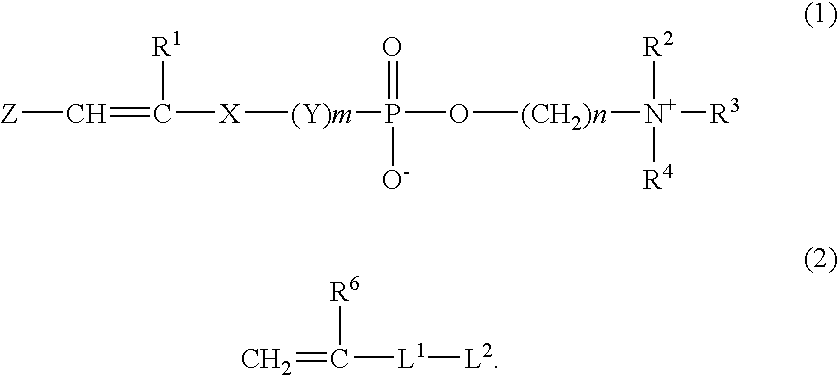Composition for hydrogel, hydrogel and use thereof
a technology of hydrogel and hydrogel, which is applied in the field of hydrogel, can solve the problem that the gel cannot be prepared directly from the copolymer solution, and achieve the effects of excellent safety, favorable properties in various biocompatible materials, and substantial water-soluble properties
- Summary
- Abstract
- Description
- Claims
- Application Information
AI Technical Summary
Benefits of technology
Problems solved by technology
Method used
Image
Examples
synthetic example 1
Synthesis of (MPC0.8-butyl methacrylate0.2) copolymer
334.7 g of MPC was dissolved in 562.5 g of water and put in a four-necked flask. 40.3 g of butyl methacrylate was dissolved in 562.5 g of ethanol, and this solution was added to the MPC solution. The mixture was bubbled with nitrogen gas for 30 minutes. The mixture was then kept at 40° C. and admixed with 1.47 g of t-butyl peroxyneodecanoate, and polymerization reaction was performed for 4 hours. The temperature was then elevated to 60° C. and reaction was further performed for 2 hours, to obtain 1501 g of polymer liquid. The polymerization reaction ratio and molecular weight of the obtained polymer liquid were measured by GPC. As a result, the polymerization reaction ratio was 91.7% and the weight average molecular weight was 1210000.
750 g of the polymer liquid was added dropwise to 4 L of acetone / hexane (1 / 1 weight ratio) mixed solvent with stirring. The precipitate was recovered by filtration and dried in a vacuum at room tempe...
synthetic example 2
Synthesis of (MPC0.3-butyl methacrylate0.7 copolymer
84.6 g of MPC was dissolved in 486 g of water and put in a four-necked flask. 95.4 g of butyl methacrylate was dissolved in 1134 g of ethanol, and this solution was added to the MPC solution. The mixture was bubbled with nitrogen gas for 30 minutes. The mixture was then kept at 50° C. and admixed with 4.40 g of t-butyl peroxyneodecanoate, and polymerization reaction was performed for 3 hours. The temperature was then elevated to 60° C. and reaction was further performed for 2 hours, to obtain 1804 g of polymer liquid. The polymerization reaction ratio and molecular weight of the obtained polymer were measured by GPC. As a result, the polymerization reaction ratio was 95.2% and the weight average molecular weight was 120000.
900 g of the polymer liquid was added dropwise to 4 L of acetone / hexane (1 / 1 weight ratio) mixed solvent with stirring. The precipitate was recovered by filtration and dried in a vacuum at room temperature for 48...
synthetic example 3
Synthesis of MPC Homopolyer
600 g of MPC was dissolved in 900 g of water and put in a four-necked flask. The solution was bubbled with nitrogen gas for 30 minutes. The solution was then kept at 60° C. and admixed with 11.7 g of succinyl peroxide, and polymerization reaction was performed for 6 hours, to obtain 1511 g of polymer liquid. The polymerization reaction ratio and molecular weight of the obtained polymer were measured by GPC. As a result, the polymerization reaction ratio was 95.3% and the weight average molecular weight was 1030000.
The polymer liquid was diluted with 1500 ml of ion exchanged water. The solution was put in a dialysis membrane having molecular cutoff of 12000 (manufactured by Spectrapore Co.) and immersed in 15 L of pure water (dialysis liquid). The dialysis liquid was exchanged in every 24 hours for three times, i.e., the membrane separation treatment was performed for 96 hours. The purified solution thus obtained was mixed with pure water to adjust the poly...
PUM
| Property | Measurement | Unit |
|---|---|---|
| Fraction | aaaaa | aaaaa |
| Fraction | aaaaa | aaaaa |
| Fraction | aaaaa | aaaaa |
Abstract
Description
Claims
Application Information
 Login to View More
Login to View More - R&D
- Intellectual Property
- Life Sciences
- Materials
- Tech Scout
- Unparalleled Data Quality
- Higher Quality Content
- 60% Fewer Hallucinations
Browse by: Latest US Patents, China's latest patents, Technical Efficacy Thesaurus, Application Domain, Technology Topic, Popular Technical Reports.
© 2025 PatSnap. All rights reserved.Legal|Privacy policy|Modern Slavery Act Transparency Statement|Sitemap|About US| Contact US: help@patsnap.com



